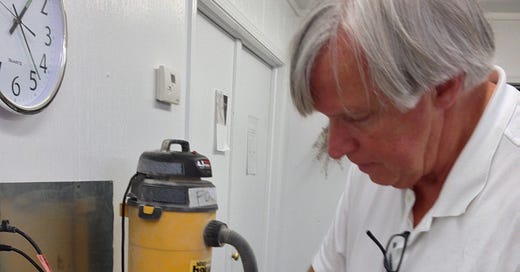The Day Benne Oil Returned
On June 13, 2013 Glenn Roberts revved up the bench top oil extruder in Anson Mills. He had a plastic culinary tube full of unhulled benne seed. We were going to cold press benne oil from the raw seeds. From 1810 to 1885 this was a common enough practice, for benne seed oil was a greatly popular culinary oil in the South. Cheaper than lard, more useful for frying than olive oil, and readily made, benne seed oil—oil pressed from the landrace for of sesame seed from West Africa—dressed the salads and fried the fish in many a southern meal. Let’s be clear about one thing from the get go: benne is a different plant than modern crop sesame. Since 1945 sesame has become a non-shattering high oil industrial crop. Benne was a lower oil (45%), shattering, and greatly flavorful seed around which several African peoples had built foodways, and around which African Americans constructed a range of dishes (benne and greens, benne and hominy, benne and oyster soup, benne biscuits, benne cakes and brittle). The oil was shelf stable, had a high smoke point, and was pleasingly flavorful (think a muted tahini).
I had spent much of 2012 reconstructing the story of culinary oil in the South, documenting the failed experiments in growing olives, the turn toward benne oil, its eclipse when David Wesson refined the stink out of Cotton Seed Oil to create a modern lipid that was odorless, colorless, and tasteless, and finally the failure of the cotton seed oil industry with the coming of the boll weevil. The derelict oil plants were converted to pressing oil from peanuts and converting the peanut mash into peanut butter. When I shared the history with Glenn Roberts he instantly wished to sample again the lost culinary oil of the 19th-century South, benne oil. The problem was where to get benne.
The old benne forms brought from Africa survive in a number of places in the western hemisphere: in Mexico, in Trinidad, in parts of South Carolina (used as seed plantings for game birds). Curiously enough most manufacturers of benne wafers in Charleston used modern sesame, not the landrace benne. Over the years Glenn and I have collected five different strains of heirloom benne, some of which we have shared with heirloom seed companies. Glenn began growing it out in 2010 to supply restaurants.
The bench top oil extruder was compact, powerful (it used a screw mechanism), and relatively economical. I think Glenn purchased it from the Ali Baba site. He set the date June 13 for the experiment, and I cleared my schedule. The press worked slowly but well, excreting a spiral of dry benne cake out the front while seeping oil into a well. The dry cake crumbled to flour and Glenn realized instantly that had been a flavoring element in old benne biscuits. There was also a foamy semi-liquid-benne cream—that form in the bottom of the well. Beautiful tasting. The oil fresh from the press was cloudy (see picture of me holding a jar below), but cleared when the oil was left to settle. The oil was a touch warm straight from the press. But its winning flavor was immediately apparent. This was something that deserved to come back!
It was not too long after this event that Glenn and Clay Oliver of Pitts Georgia connected. With Anson Mills benne seed, Clay would press the first commercially available benne oil in over a century. It would win an American Food Award.






OMG we were younger for sure! Thanks for this David.